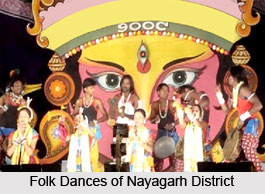 Folk dance of Nayagarh district is a significant part of their cultural heritage. Folk dances are performed by rural population to mitigate their fatigue and weary. The rural population of Nayagarh District practice and perform several types of folk dances of different disciplines. The dances are supported by folk songs and musical instructions. Some of the popular folk dances are Kaleshi, Dinda Dhangedi and Matia among others.
Folk dance of Nayagarh district is a significant part of their cultural heritage. Folk dances are performed by rural population to mitigate their fatigue and weary. The rural population of Nayagarh District practice and perform several types of folk dances of different disciplines. The dances are supported by folk songs and musical instructions. Some of the popular folk dances are Kaleshi, Dinda Dhangedi and Matia among others.
Kaleshi dance has a religious significance. The villagers propitiate the village deities to protect them from different calamities and cattle diseases. On the day of the puja, a person either a female or a male dressed as female symbolises the goddess and in a mood of daze exhibits acrobatic movement of body. She answers the questions of the devotees on behalf of the goddess. It is also called Mangala Nacha. It is usually performed in almost all throughout Nayagarh District. The generic name of Kaleshi is Shaman. In Nayagarh district, there is a poor population of the Matias who are a south Indian tribe and nomadic in nature. They perform a sort of acrobatic dance imitating monkeys and wild beasts and producing unusual sounds and beg alms. This form is referred to as Matia dance. They show their performance in public places and festivals.
Paika dance is a type of acrobatic dance by the landed militia or soldiers of the kings. The Kings are no more, but the heirs of the Paikas are there. They imitate the war dance of their ancestors and dance during dussehra and other festive occasions. Dala Mankudi is a seasonal dance. In the summer season, young boys clad with Jamu branches dance in groups holding prong and visit the doors of different houses. The purpose is to appeal the Rain-God for rain. The house-wives, throw turmeric waters to these dancing boys. It is a ritual dance. Kela Nacha is a dance form practiced by the Kela community. A branch of this community performs acrobatic feats around a long bamboo firmly fixed to the ground. This game is very risky and dangerous. It is still prevalent in Machhipada area of Nayagarh district. Dhuduki is a very fascinating folk dance prevalent almost in all parts of Orissa. Dhuduki is a rustic instrument with a string. The main player sings chanting rhythms with the string. Two young boys dressed as females dance to this rhythm.
Duari dance is a unique dance from based on many theological stories, like Subhadra Parinaya, killing of Gosing Dailya etc. Dhumpa is another folk dance form and the pioneers of this dance form are the families of Pathani Samanta. This dance has gained national and international acknowledgment. A troop performing Dhumpa comprises a Principal Singer, four or five chorus singers, six or eight kathias or stick drummers, a pot-belled man and a gotipua dancer. A typical performance begins with a verse rendered by the principal singer with accompanying instrument like Harmonium, Tabla, Flute, Vina and a Mardal. The one side of the trunk face towards the pot-belled man, which hags from above ropes are pulled down to strike his belly in perfect rhythm emitting a deep and sonorous sound and the stick drummers beating the trunk also creates sound. This instrument is called Dhumpa.
There are two types of Danda dance form prevalent in Nayagarh district namely Danda and Udanda. Danda is performed in the month of Chaitra, and Udanda in the month of Baisakha. It is basically observation of religious fast for a period of twenty one days by devotees for fulfillment of their certain cherished desire. Lord Shiva, Goddess Kali and Parvati are the presiding deity and remains in form of an ever burning fire in a fire torch (Masal), four in numbers. The devotees remain sleepless during the night where Danda Dance (Nrutya) is performed before the Lord. The three different form of Danda are Pani Danda, Dhuli Danda and Agni Danda. Veeravadya is a tribal dance from of Daspalla. Originally it is a dance of the Kandha community .It is famous in Dasapalla and Khandapara. It is also known as Singhbaja.
Thus it can be concluded that there varied forms of folk dances are an indispensable part of the culture of Nayagarh district of Orissa.



















